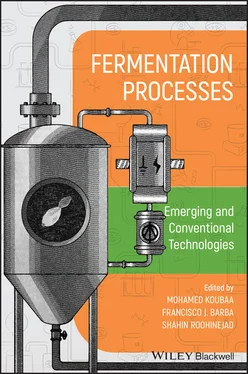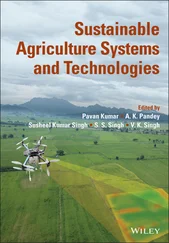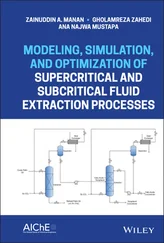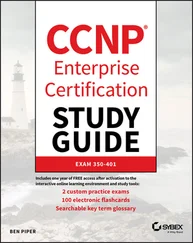1 Cover
2 Title Page Fermentation Processes Emerging and Conventional Technologies Edited by Mohamed Koubaa ESCOM, UTC, EA 4297 TIMR, Compiègne, France Francisco J. Barba Faculty of Pharmacy, Preventive Medicine and Public Health, Food Science, Toxicology and Forensic Medicine Department, Universitat de València, València, Spain Shahin Roohinejad Burn & Wound Healing Research Center, Shiraz University of Medical Science, Shiraz, Iran
3 Copyright Page
4 About the Editors
5 List of Contributors
6 Preface
7 1 Introduction to Conventional Fermentation Processes 1.1 Bioprocesses 1.2 Energetic Metabolism 1.3 Microorganisms Used in Fermentation Processes 1.4 Fermentation Technology 1.5 Conclusions References
8 2 Current Developments in Industrial Fermentation Processes 2.1 Introduction 2.2 Main Achievements in Industrial Fermentation 2.3 Current Developments in Industrial Fermentation 2.4 Conclusions References
9 3 Culture Condition Changes for Enhancing Fermentation Processes 3.1 Introduction 3.2 Culture Media Used for Fermentation 3.3 Metabolic Approaches 3.4 Conclusions References
10 4 Emerging Technologies and Their Mechanism of Action on Fermentation 4.1 Introduction 4.2 HHP Processing 4.3 Ultrasound 4.4 Pulsed Electric Fields 4.5 Microwaves 4.6 Conclusions Acknowledgments References
11 5 Biomass Fractionation Using Emerging Technologies 5.1 Introduction 5.2 Ultrasound Application for Biomass Fractionation 5.3 Microwave Application for Biomass Fractionation 5.4 PEF Application for Biomass Fractionation 5.5 Enzyme‐Assisted Fractionation of Biomass 5.6 SCF Fractionation of Biomass 5.7 Conclusions References
12 6 Enhancing Microbial Growth Using Emerging Technologies 6.1 Introduction 6.2 Microbial Stimulation Using EFs 6.3 Stimulation Using US 6.4 Microbial Stimulation Using HP 6.5 Conclusions Acknowledgments References
13 7 Application of Fermentation to Recover High‐Added Value Compounds from Food By‐Products 7.1 Introduction 7.2 Food Industry By‐Products and Global Estimates 7.3 Food By‐Products as Sources of Antifungals or Antioxidants 7.4 Fermentation as a Strategy for Food By‐Product Valorization 7.5 Recovery of High‐Added Value Compounds from Food By‐Products 7.6 Technical and Economical Hurdles in Fermentation Assisted Recovery 7.7 Conclusions and Future Outlook References
14 Index
15 End User License Agreement
1 Chapter 2 Table 2.1 Products provided by biological processes. Table 2.2 Names of some industrial fermentation companies with their fields o... Table 2.3 Rapid methods of analyses of yeast physiology and fermentation para... Table 2.4 Global world ethanol production in recent years (millions of liters... Table 2.5 Different types of enzymes produced by solid‐state fermentation. Table 2.6 Productions of biofuels by sugar fermentation of agro‐food residues...Table 2.7 Productions of organic acids by sugar fermentation of agro‐food res...Table 2.8 Productions of triacylglycerols by sugar fermentation of agro‐food ...Table 2.9 The major groups of recombinant proteins developed as therapeutic a...Table 2.10 Major culture collections and their corresponding website address.Table 2.11 Genetically modified Saccharomyces cerevisiae yeast strains for bio...Table 2.12 Minimum quantities of elements to include in an initial medium (a)...Table 2.13 Main types of solid‐state fermentation bioreactors along with thei...Table 2.14 Application of high‐ and low‐frequency ultrasound in food fermenta...Table 2.15 Summary of the physical and biological model terms and their typic...Table 2.16 Summary of substrate, pH,carbon‐to‐nitrogen ratio, car...Table 2.17 Summary of different advanced bioreactor configurations for biohyd...
2 Chapter 3Table 3.1 Average elemental composition of bacteria, yeasts, and fungi (by % ...Table 3.2 Description of the typical concentration ranges of mineral componen...
3 Chapter 5Table 5.1 Example of applications and experimental conditions of ultrasound f...Table 5.2 Examples of applications and experimental conditions of microwave f...Table 5.3 Examples of applications and experimental conditions of pulsed elec...Table 5.4 Some examples of bioactive compounds fractionated by enzyme‐assiste...Table 5.5 Selected examples of bioactive compounds extracted from several sou...
4 Chapter 6Table 6.1 General effects of sublethal electric fields on microbial cell grow...Table 6.2 General effects of ultrasounds on microbial cell growth and ferment...Table 6.3 General effects of high pressure on microbial cell growth and ferme...
1 Chapter 1 Figure 1.1 Energy coupling and the role of ATP in microbial metabolism. ADP:... Figure 1.2 Glycolysis and citric acid cycle pathways. Figure 1.3 The electron transport chain showing the respiratory complexes. Figure 1.4 Schematic representation of fermentation and energy generation. Figure 1.5 Main terminal reactions of catabolic fermentations using pyruvate... Figure 1.6 Schematic representation of a prokaryotic cell (a) and a budding ... Figure 1.7 Diagram of a typical gene cloning methodology and cell banking sy... Figure 1.8 Factory seed culture equipment. AF = air filter; FIC = flow indic... Figure 1.9 Fermenter vessel schematic and terminology.
2 Chapter 2 Figure 2.1 Novel and traditional fermented foods. Figure 2.2 General schemes for beverage alcohol and bioethanol production. Figure 2.3 Schematic of dry grind process for ethanol production from corn (...Figure 2.4 Yeast strain developmental cycle for alcohol fermentations.Figure 2.5 Main types of bioreactors: (a) tray, (b) packed‐bed, (c) fluidize...Figure 2.6 Distribution of solid‐state fermentation–related patent applicati...Figure 2.7 Historical overview of efforts to influence fermentations by elec...Figure 2.8 Schematic of fermentation process.Figure 2.9 Suitable model structures for applying mechanistic process models...
3 Chapter 3Figure 3.1 Schematic representation of metabolism modeling.Figure 3.2 Schematic representation of bioreaction.Figure 3.3 Dissolved oxygen concentration increases in a solution during a p...
4 Chapter 4Figure 4.1 Worldwide trend of HHP food production.Figure 4.2 Application of high‐pressure processing.Figure 4.3 Frequency ranges of ultrasound and corresponding applications (Wi...Figure 4.4 The utilization of ultrasound reflection in testing of materials....Figure 4.5 The propagation of ultrasonic wave (a) compression and refraction...Figure 4.6 The practical applications of ultrasound.Figure 4.7 Schematic presentation of (a) irreversible and (b) reversible ele...Figure 4.8 Schematic diagram of Enbio Jet ®continuous microwave heating...
5 Chapter 5Figure 5.1 Enzyme‐assisted extraction of compounds from plant materials.
6 Chapter 6Figure 6.1 The two main approaches presented in the literature for the use o...
7 Chapter 7Figure 7.1 Main by‐products generated from meat, seafood, dairy, fruit, and ...Figure 7.2 Microbial species thrive and release bioactive metabolites from m...
1 Cover Page
2 Fermentation Processes
3 Fermentation Processes
4 About the Editors
5 List of Contributors
6 Preface
7 Table of Contents
8 Begin Reading
9 Index
10 WILEY END USER LICENSE AGREEMENT
1 iii
2 iv
3 ix
4 x
5 xi
6 xii
7 xiii
8 xiv
9 1
10 2
11 3
12 4
13 5
14 6
15 7
16 8
17 9
18 10
19 11
20 12
21 13
22 14
23 15
24 16
25 17
26 18
27 19
28 20
29 21
Читать дальше












